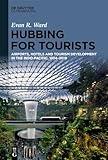Hubbing for Tourists : Airports, Hotels and Tourism Development in the Indo-Pacific, 1934–2019 / Evan R. Ward.
Material type: TextPublisher: München ; Wien : De Gruyter Oldenbourg, [2023]Copyright date: ©2023Description: 1 online resource (X, 223 p.)Content type:
TextPublisher: München ; Wien : De Gruyter Oldenbourg, [2023]Copyright date: ©2023Description: 1 online resource (X, 223 p.)Content type: - 9783111324869
- 9783111327631
- 9783111326641
- 338.4/791091732 23/eng/20231004
- G155.A78 W37 2023
- online - DeGruyter
- Issued also in print.
| Item type | Current library | Call number | URL | Status | Notes | Barcode | |
|---|---|---|---|---|---|---|---|
 eBook
eBook
|
Biblioteca "Angelicum" Pont. Univ. S.Tommaso d'Aquino Nuvola online | online - DeGruyter (Browse shelf(Opens below)) | Online access | Not for loan (Accesso limitato) | Accesso per gli utenti autorizzati / Access for authorized users | (dgr)9783111326641 |
Frontmatter -- Acknowledgements -- Contents -- Introduction -- Chapter 1 Before Dubai: The Shah, the Frank Lloyd Wright Foundation and Persian Gulf, 1967–1969 -- Chapter 2 “An Entrepot for Tourists:” Gateway Travel in the Indo-Pacific, 1934–2019 -- Chapter 3 Asian Hotel Networks in the Age of Aviation -- Chapter 4 Australia’s Integration with Asia in the Age of Aviation -- Chapter 5 Low-Cost Carriers and Hubs in the Indo-Pacific -- Conclusion -- Bibliography -- Index
restricted access online access with authorization star
http://purl.org/coar/access_right/c_16ec
Dubai International Airport (DXB), Emirates Airlines, and the Burj al-Arab. Changi International Airport (SIN), Singapore Airlines, and Marina Bay Sands. Chek Lap Kok (HGK), Cathay Pacific, and The Peninsula Hotel. Kingsford Smith (SYD), Qantas Airlines, and the Wentworth Hotel. What do these collective entities have in common? Not only do they link global air hubs with city-centric long-haul airlines and destination-worthy hotels, but they are the product of a distinct strategy to boost tourism development through the synergies created by aviation development. This volume explores the evolution of tourism development through synergies created by airline, airport, and hotel development in the Persian Gulf (namely Dubai); Southeast Asia (primarily Singapore); and East Asia (mainly Hong Kong) during the twentieth and twenty-first centuries. These "hubs" included, but went beyond traditional models of hotel development as models for economically viable tourism programs, particularly after World War II. The book also examines how such systems integrated travelers, airlines, and airports in Australasia and Europe, while at the same time competing with imperial systems of airport and airline development. This book illuminates the strategies behind and competition between cities during the current century for air traffic, tourists, and airlines transiting between Europe, Southeast Asia, and Australasia.
Issued also in print.
Mode of access: Internet via World Wide Web.
In English.
Description based on online resource; title from PDF title page (publisher's Web site, viewed 02. Jun 2024)


